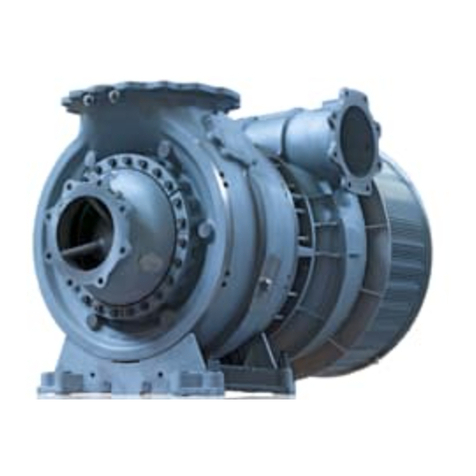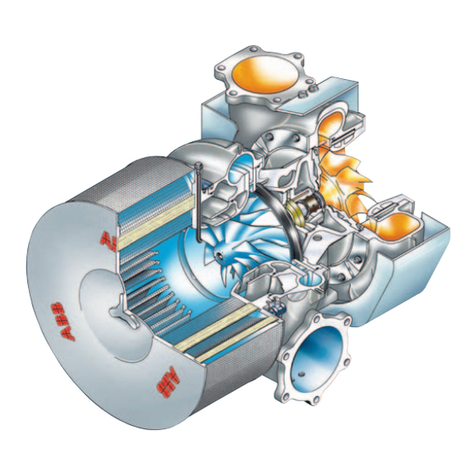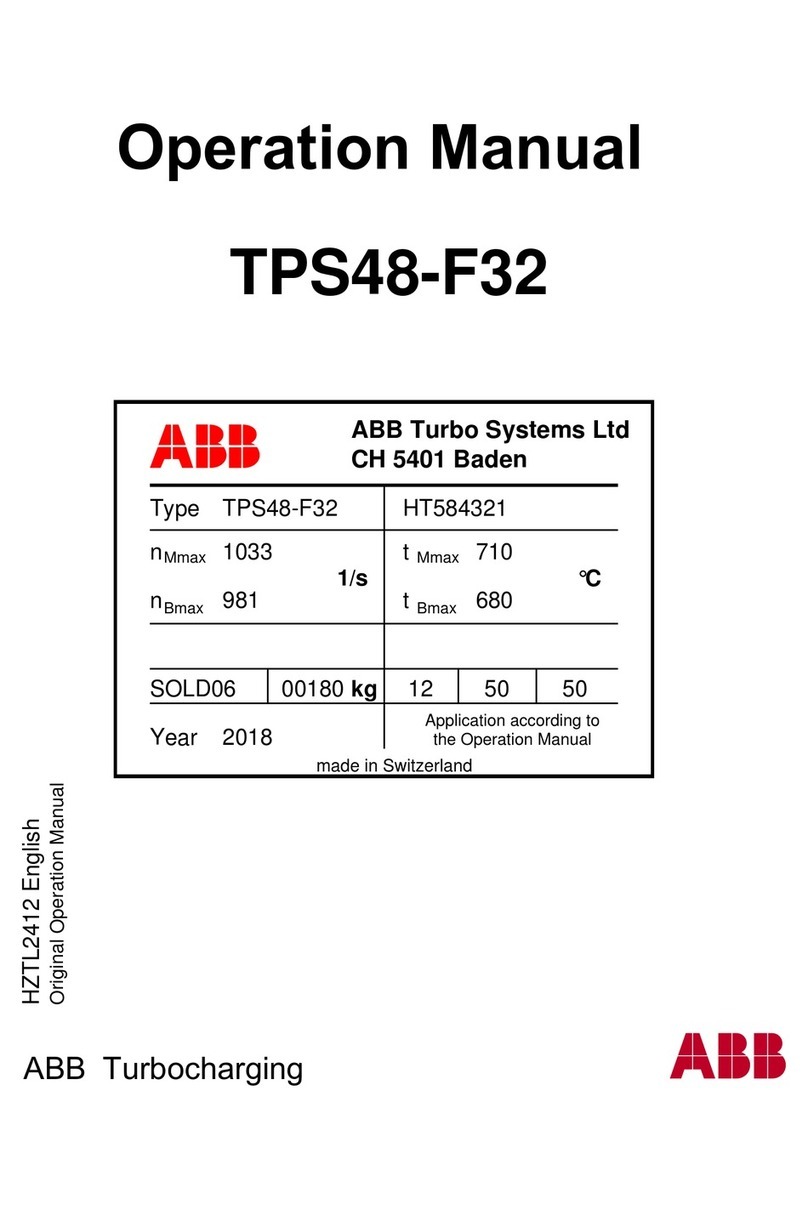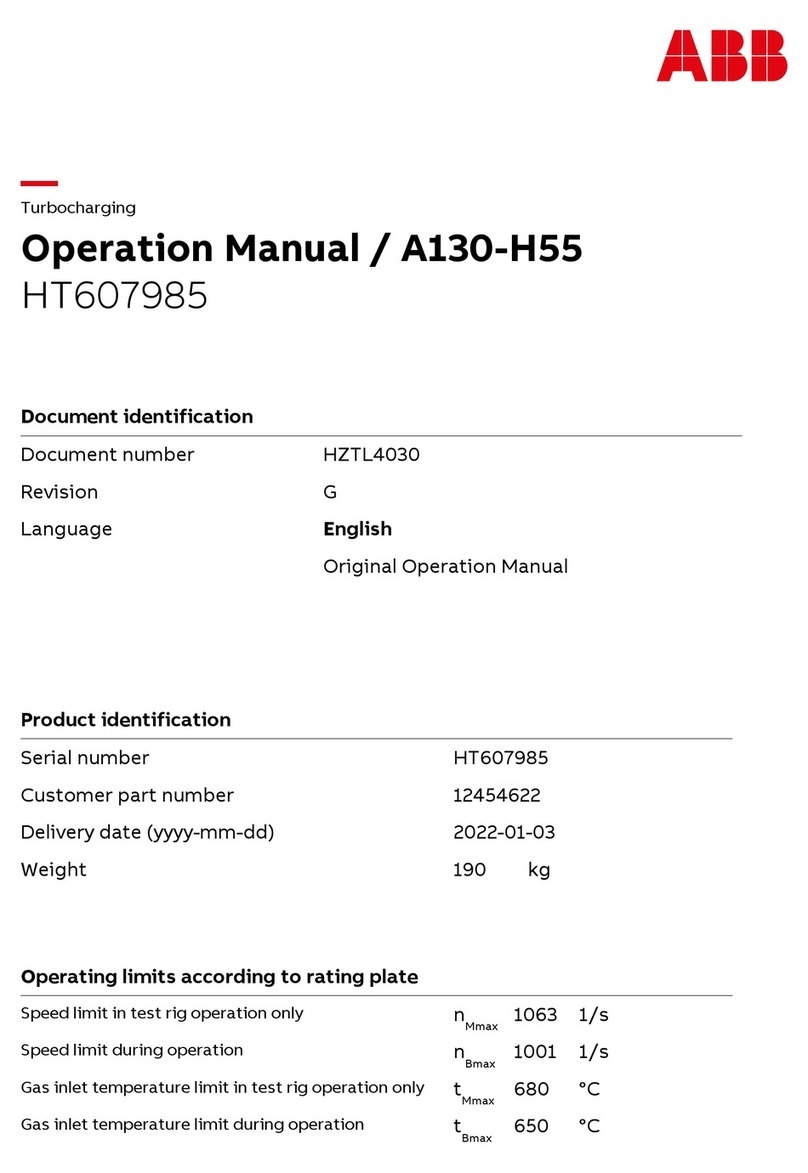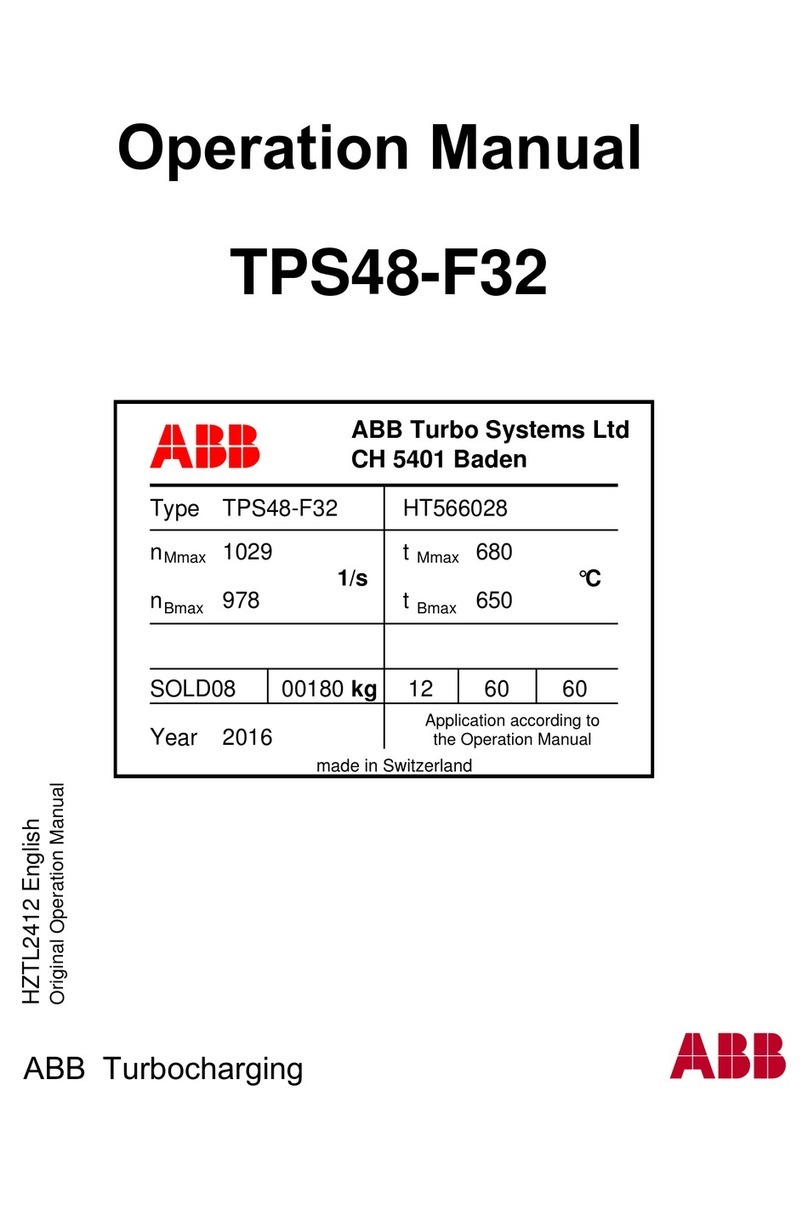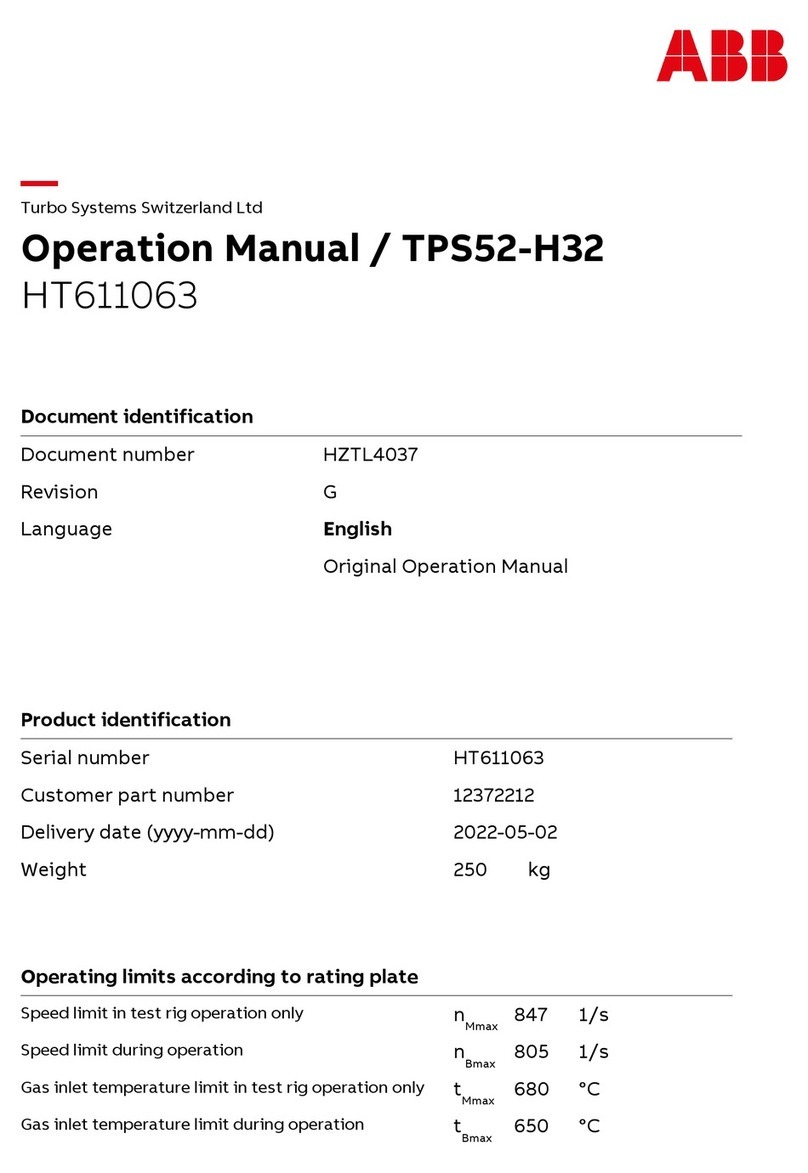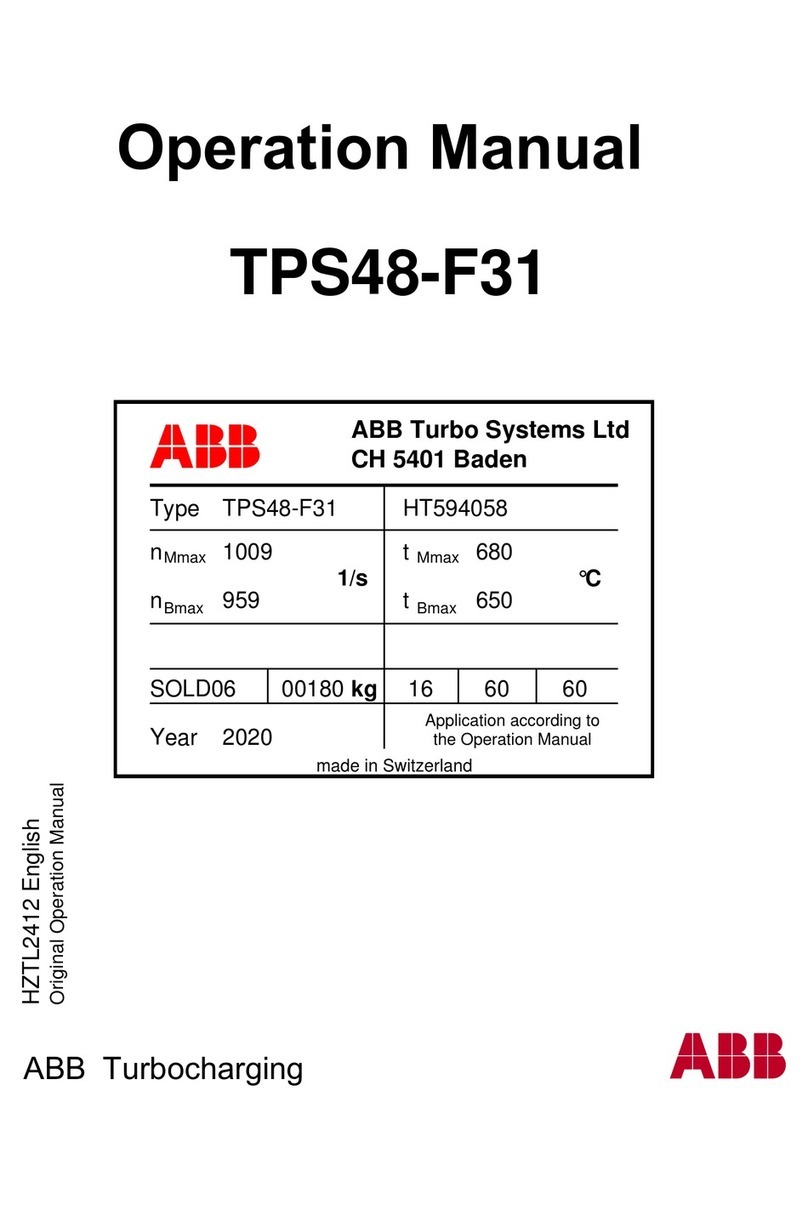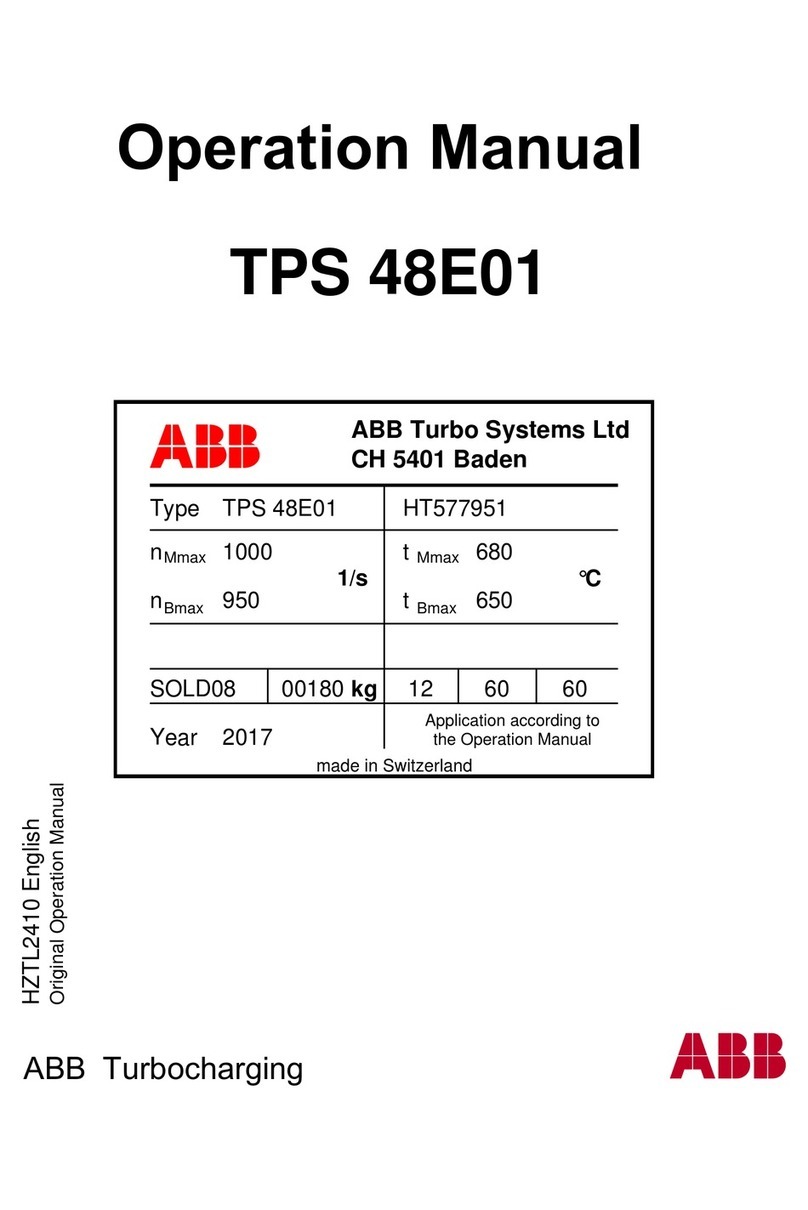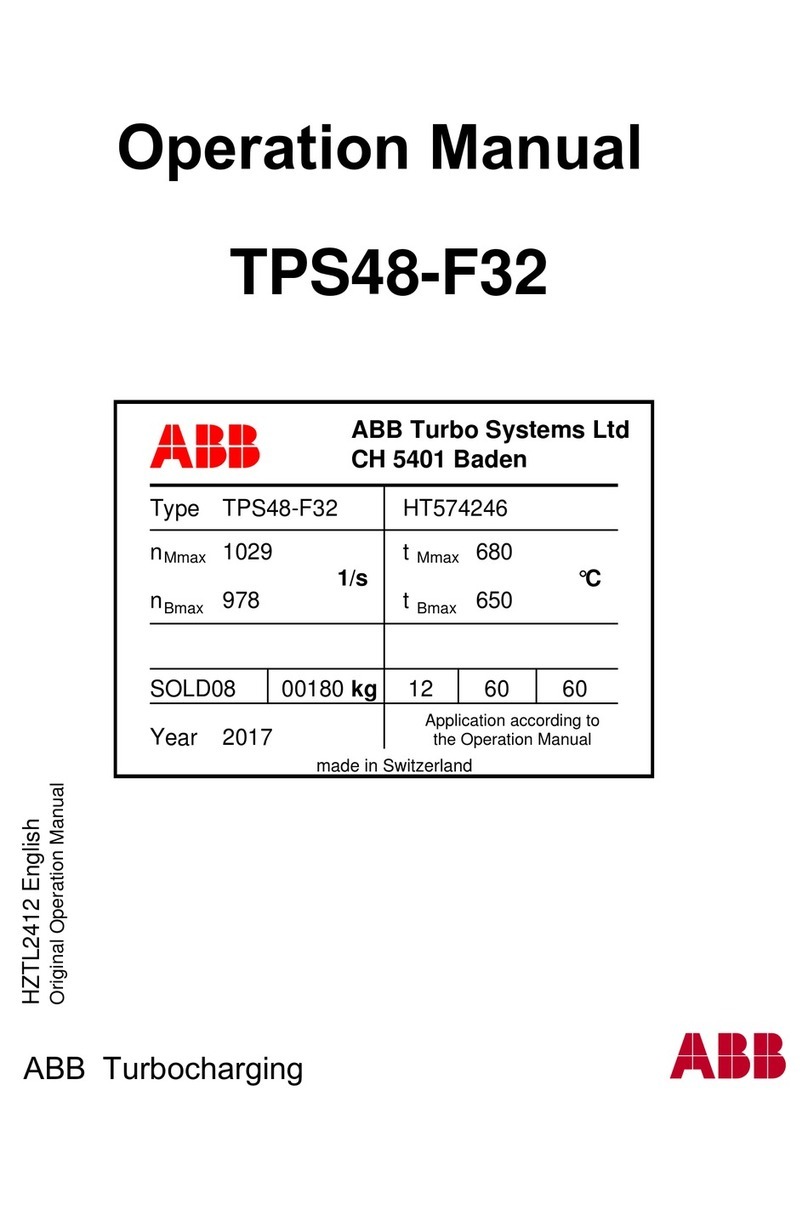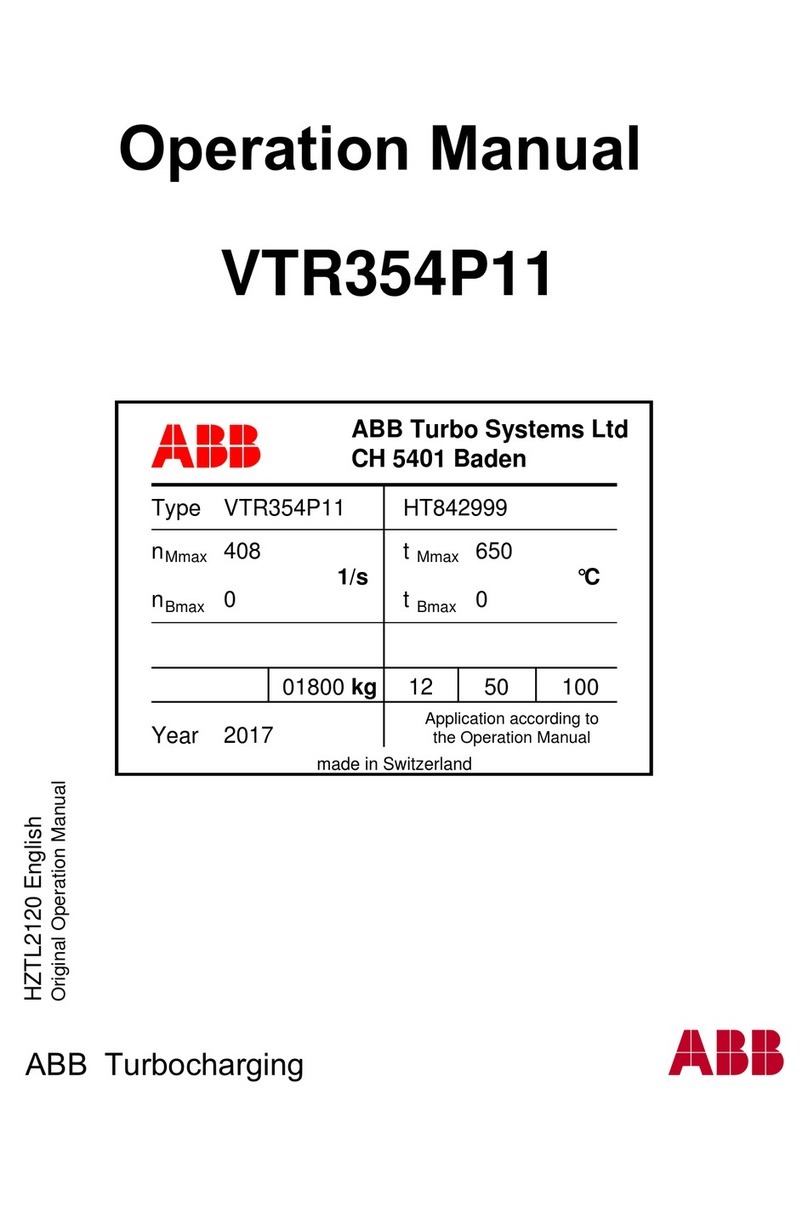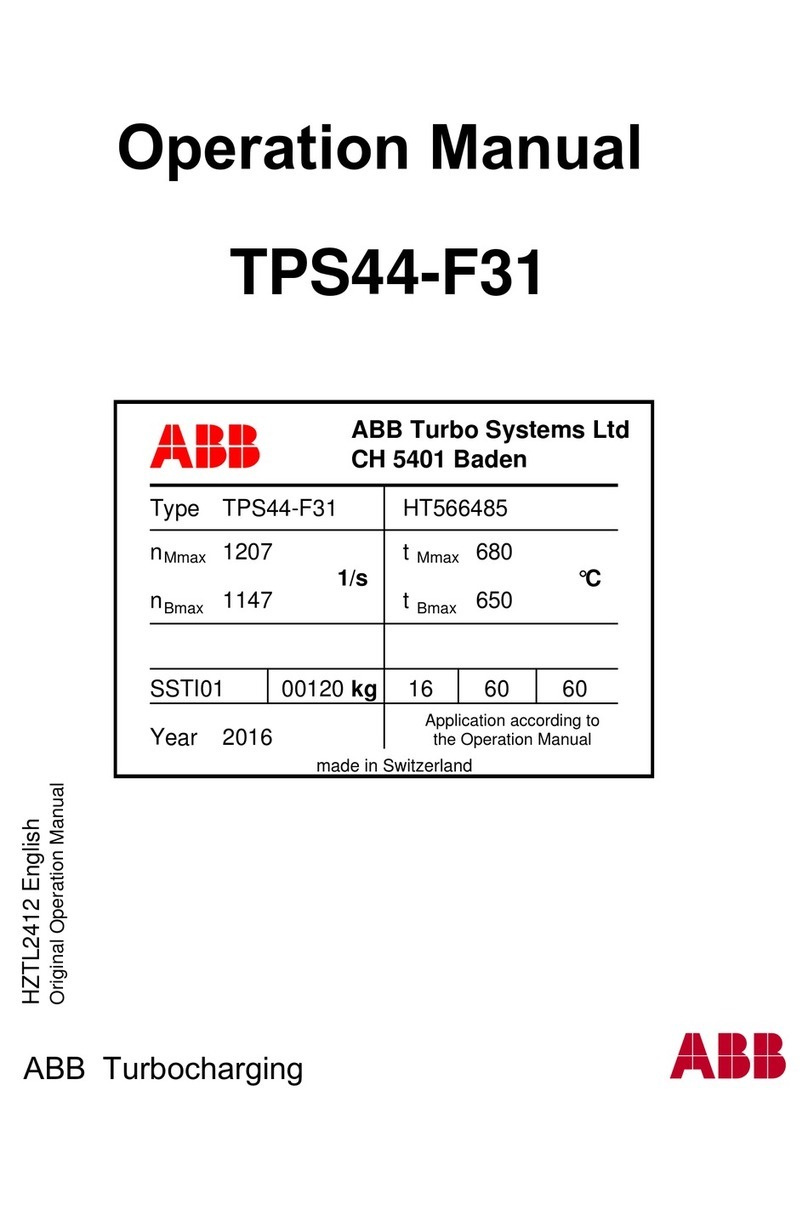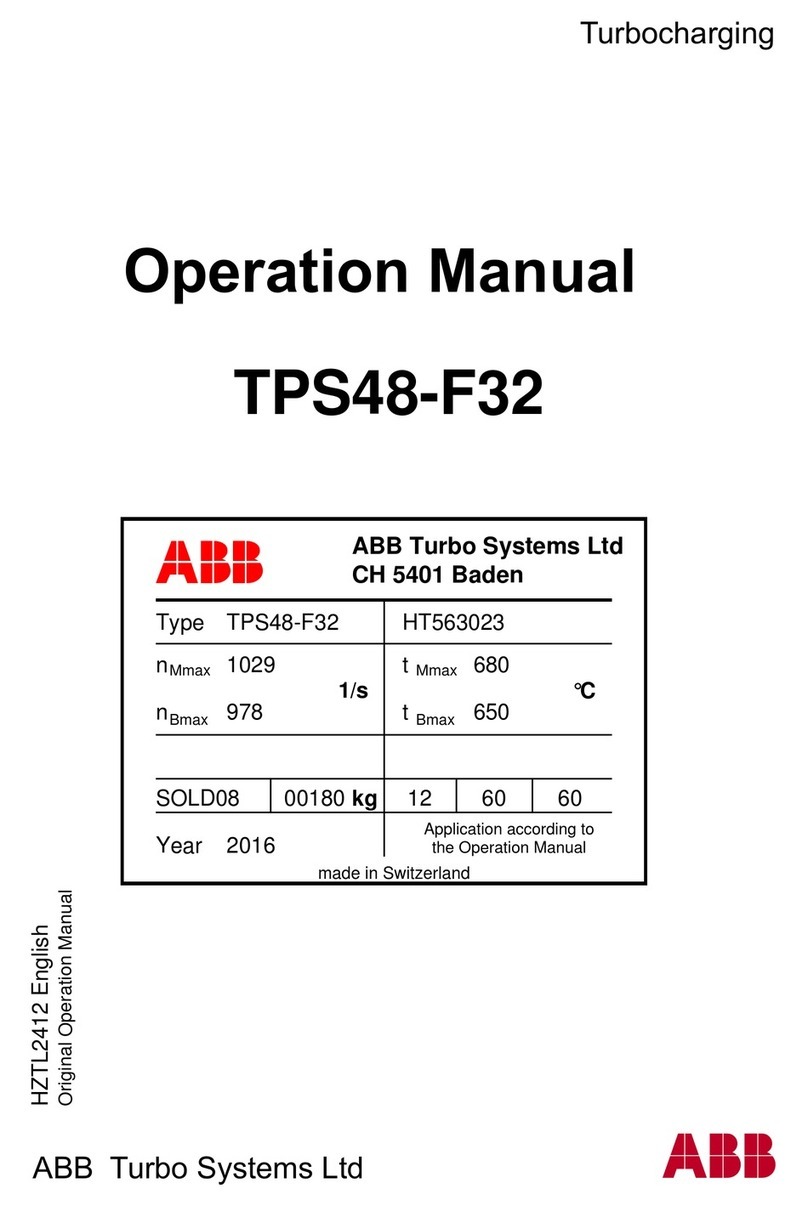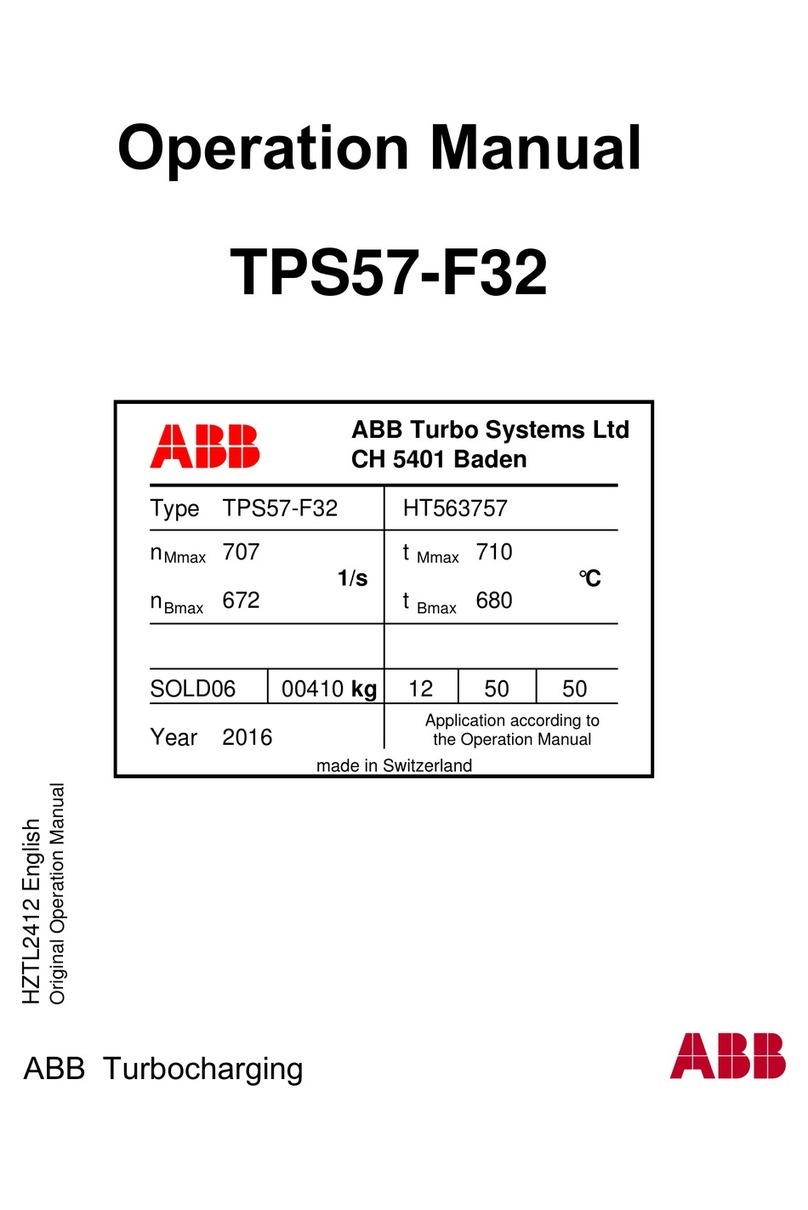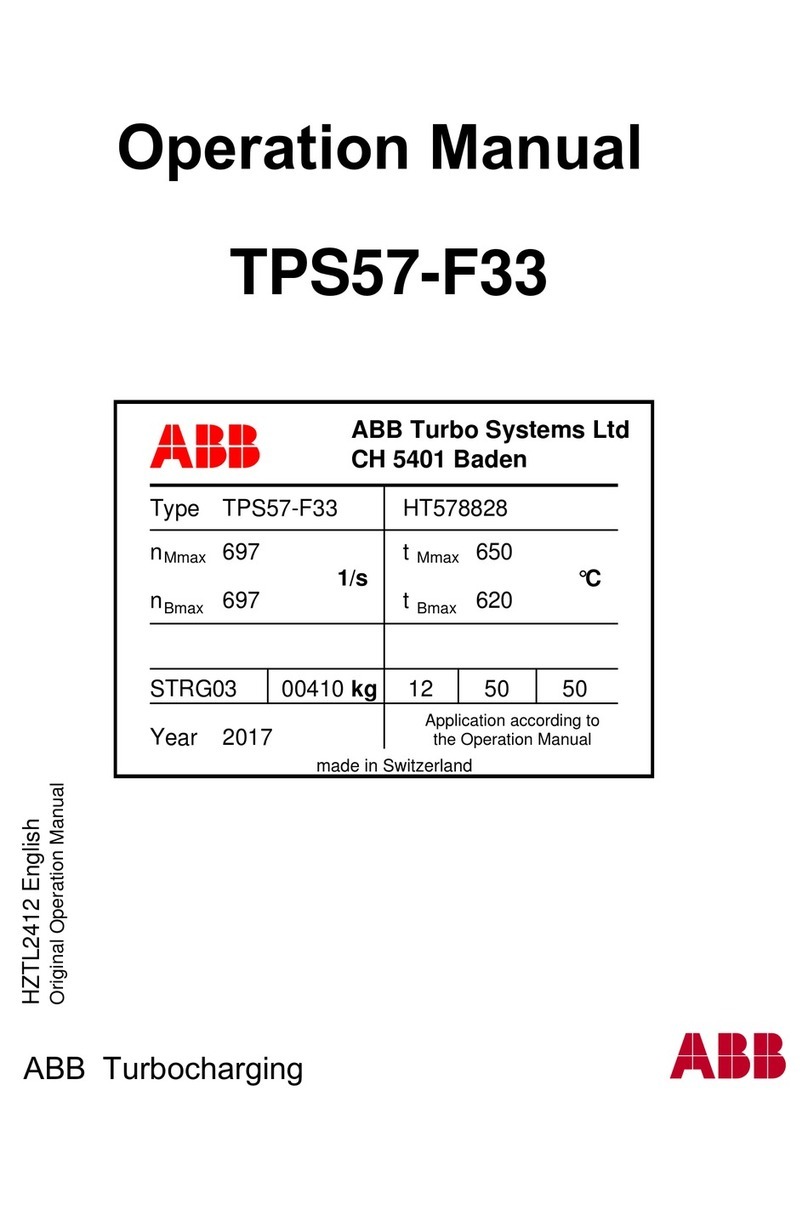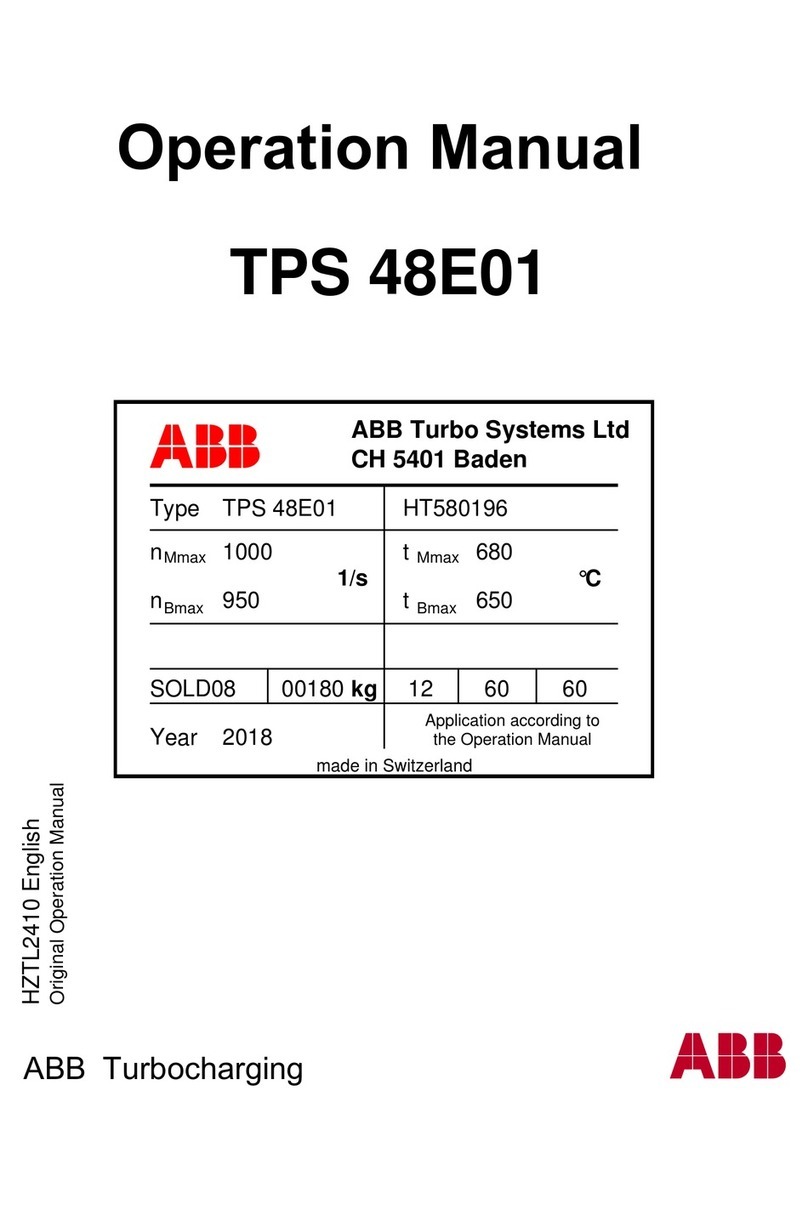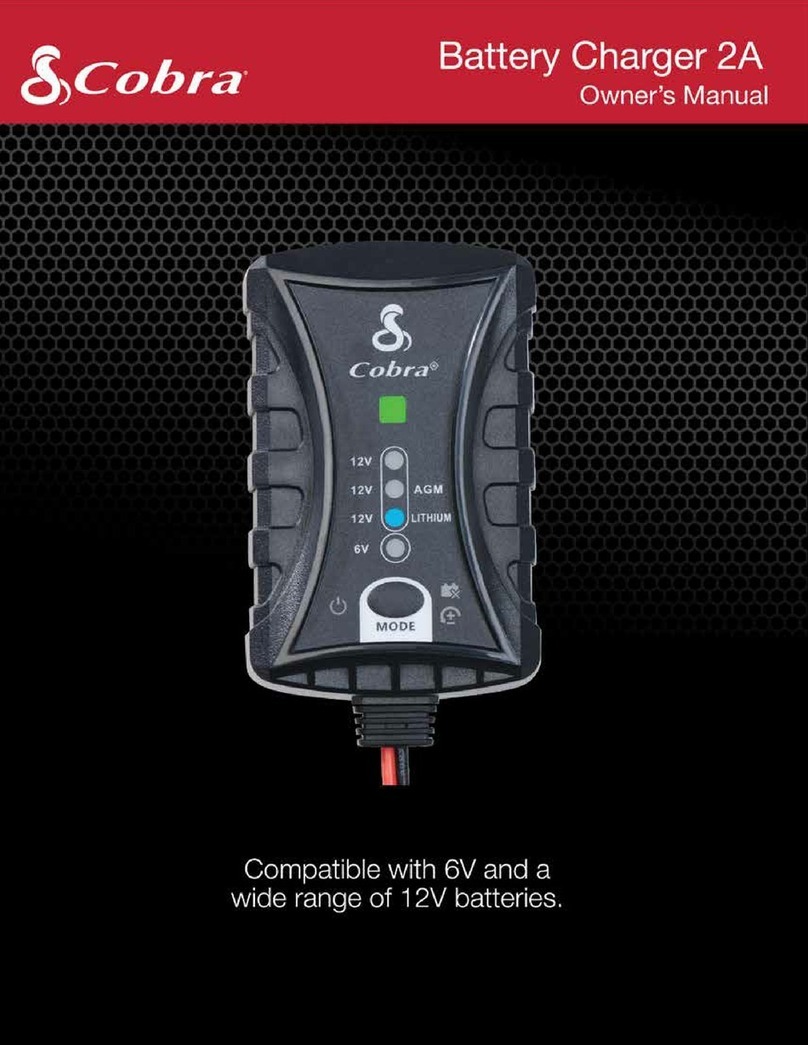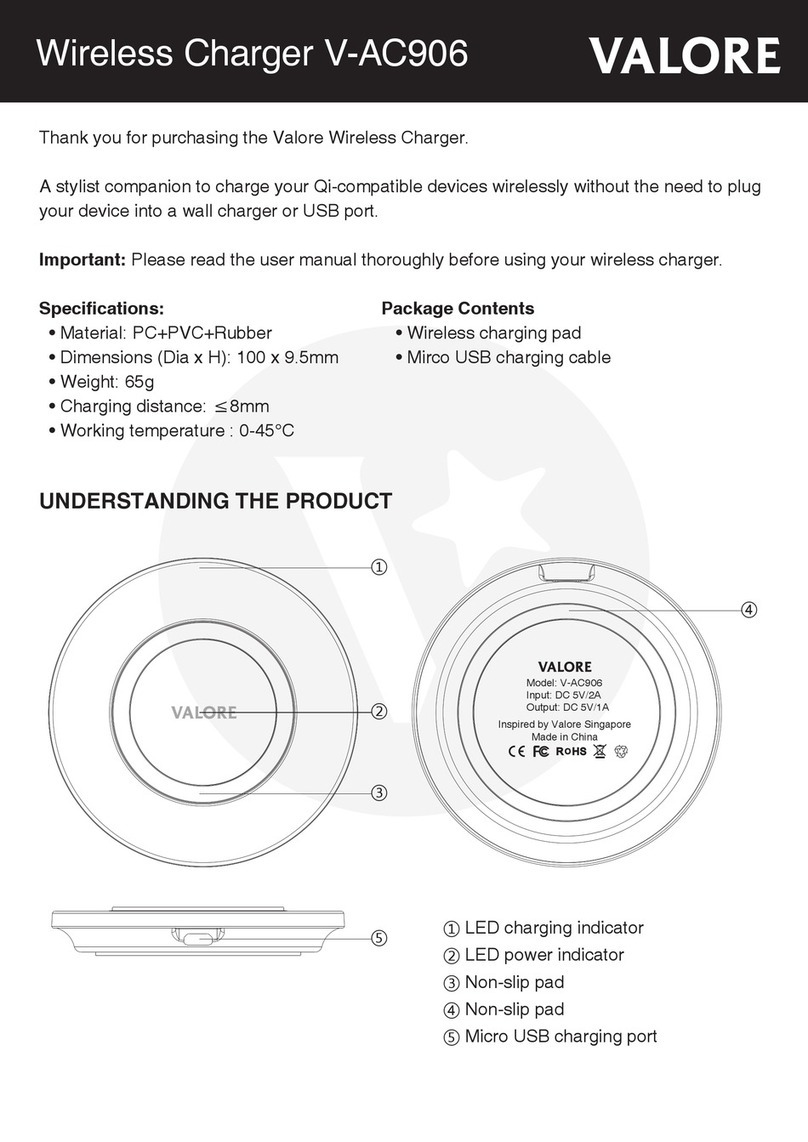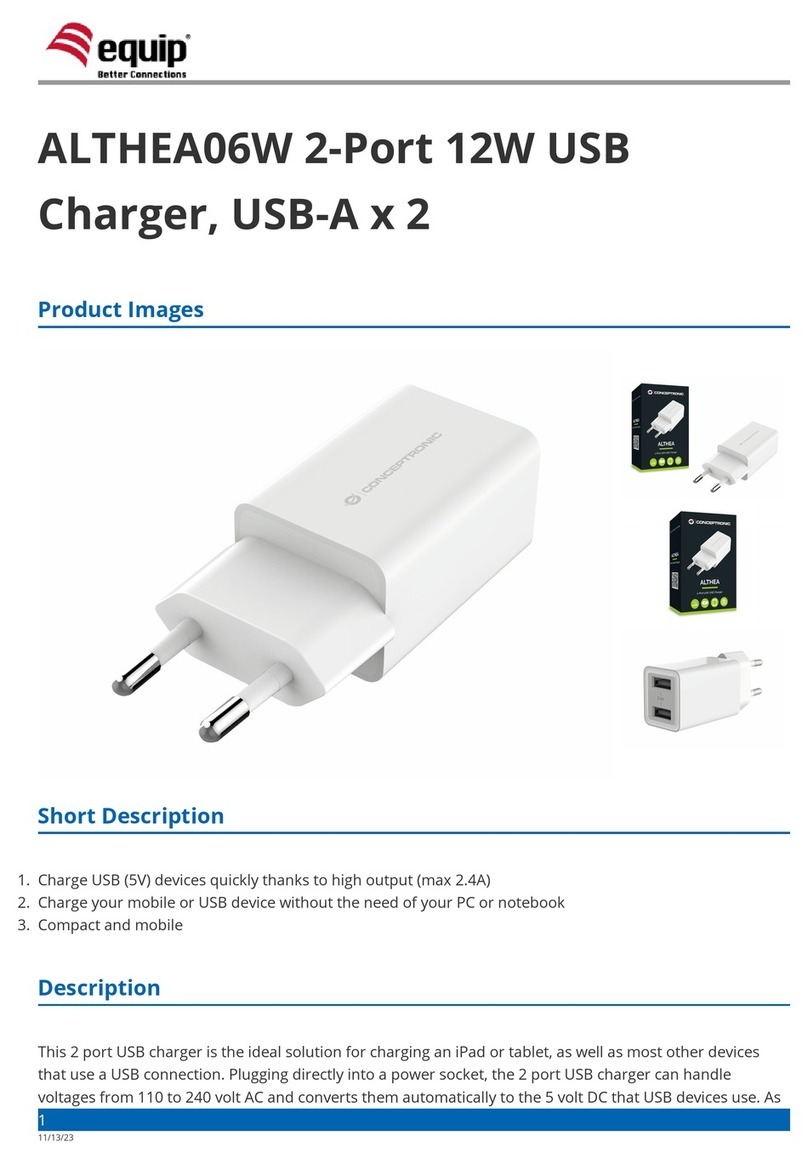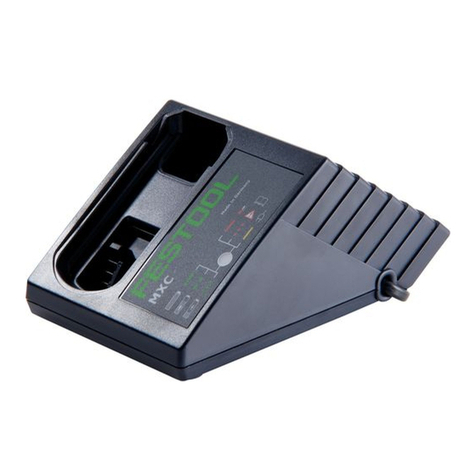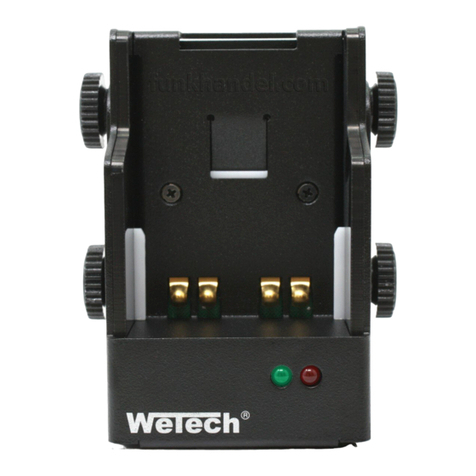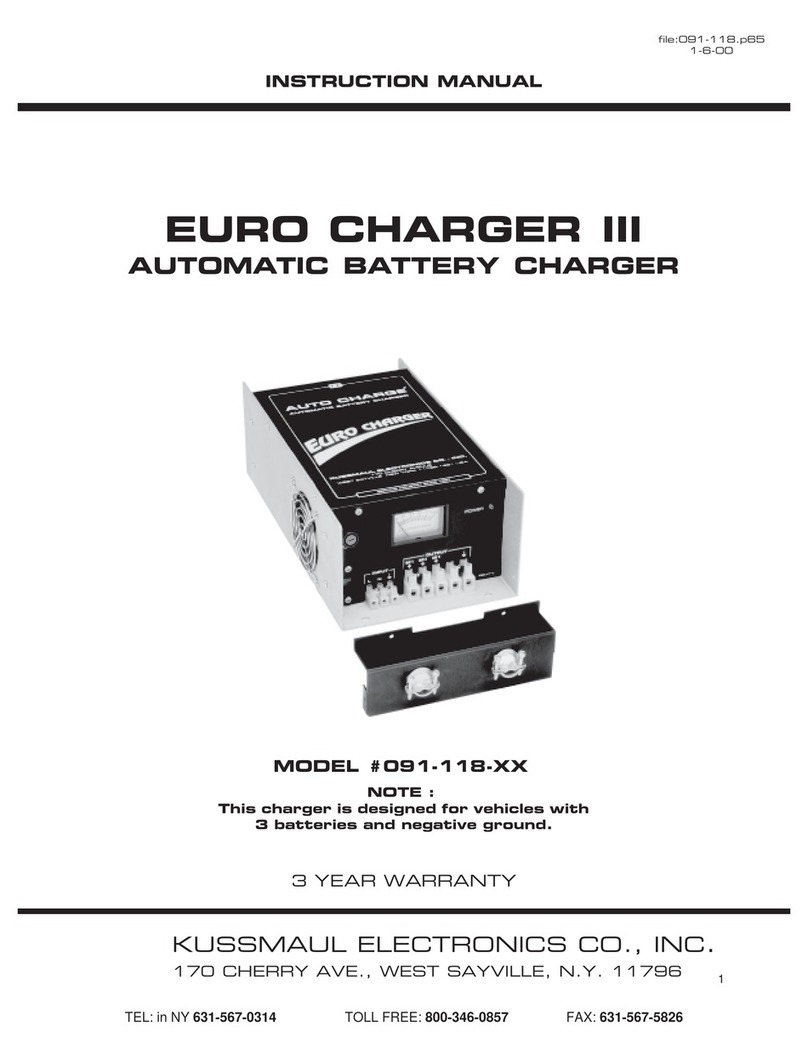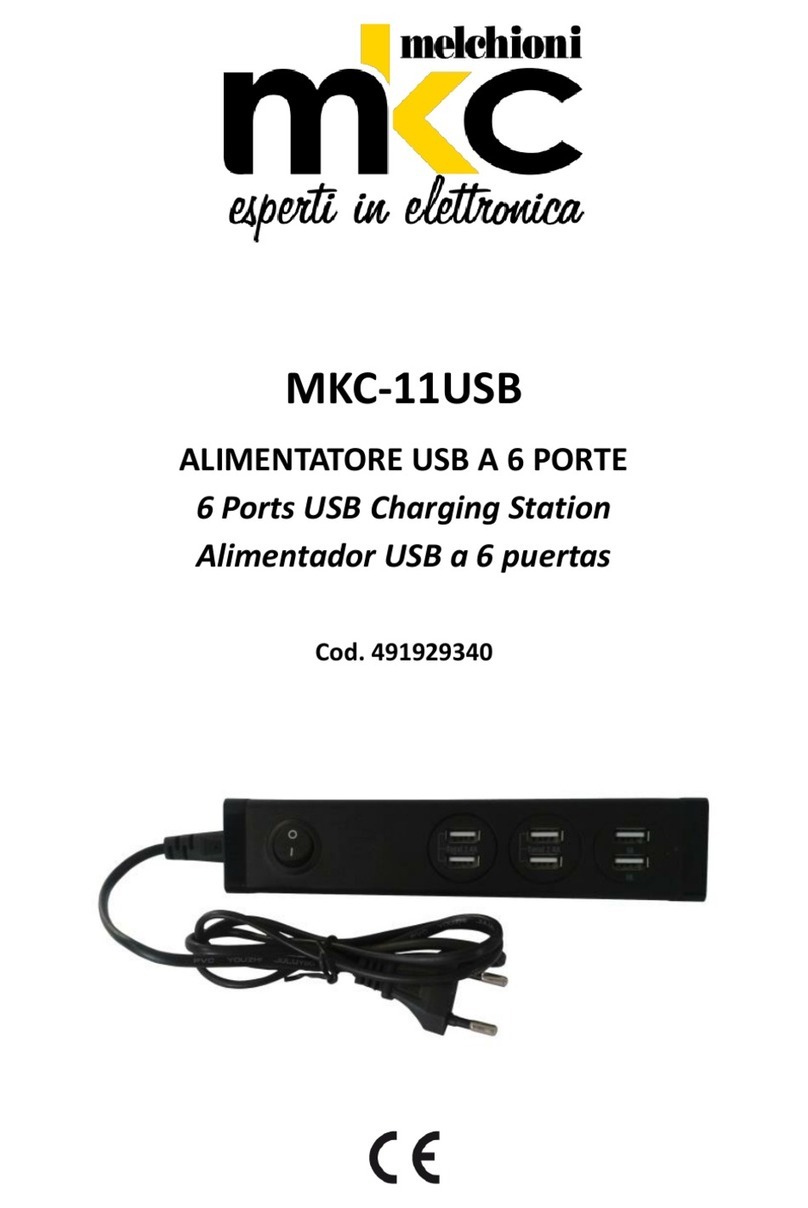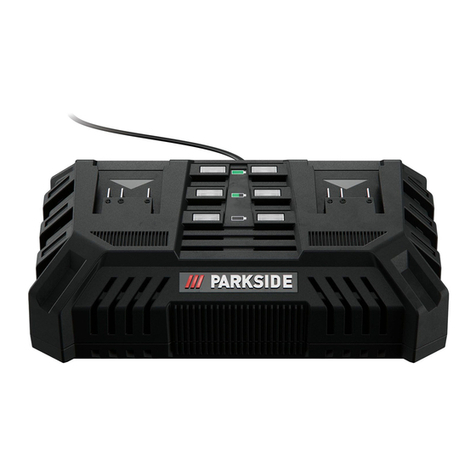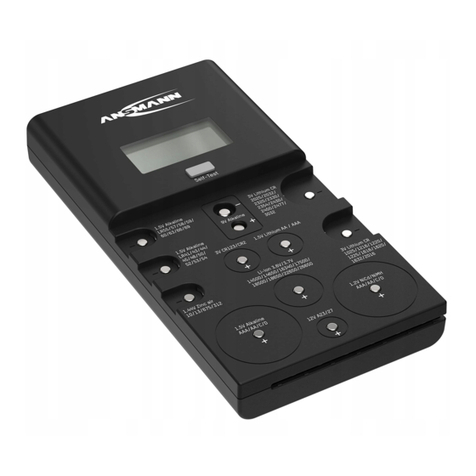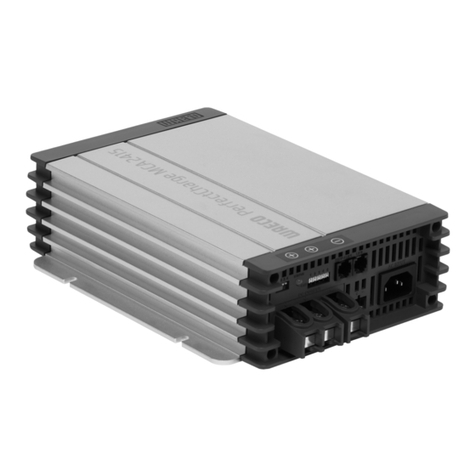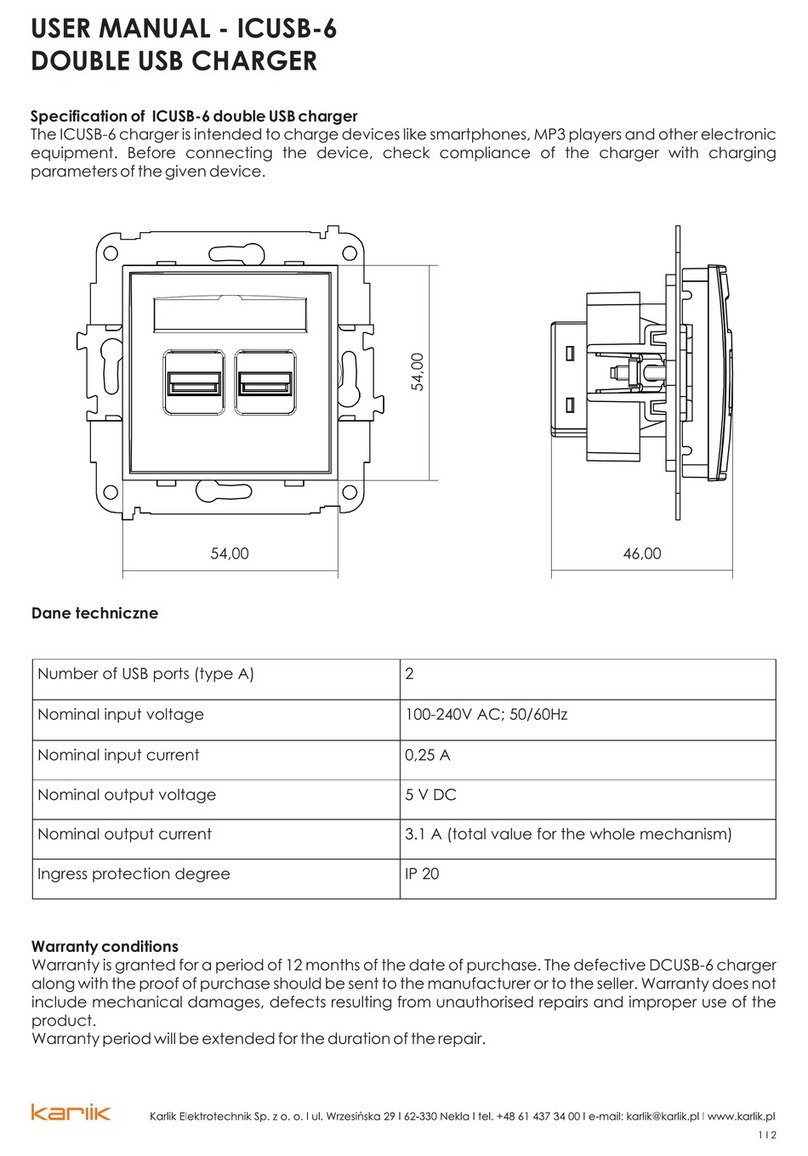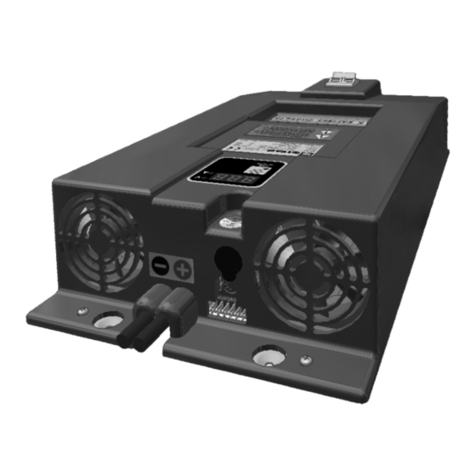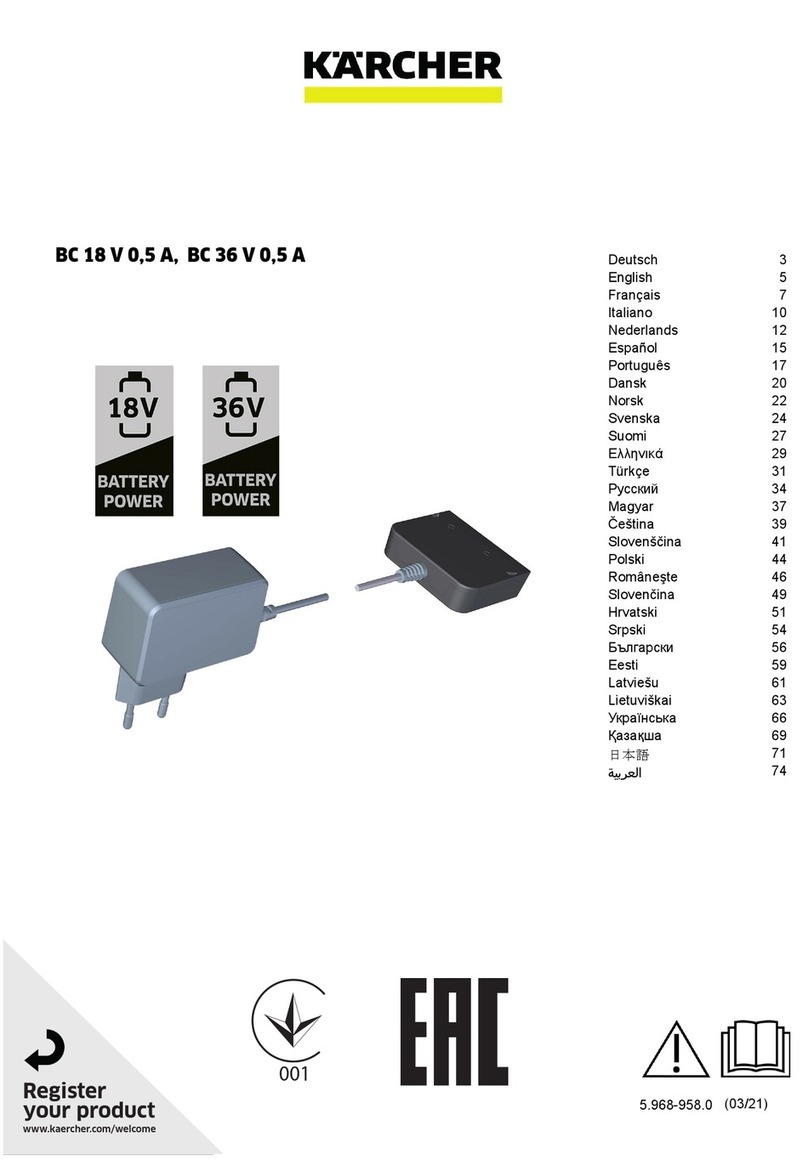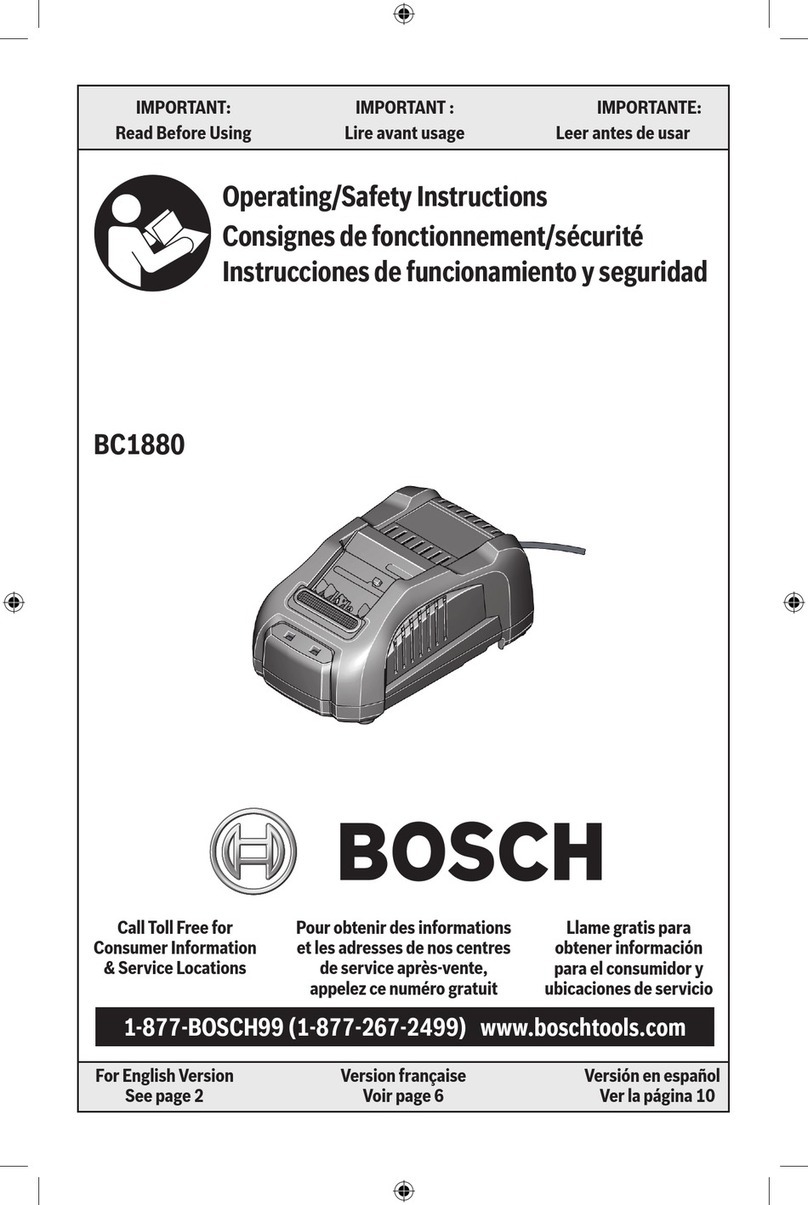ABB HT604150 User manual

Turbocharging
Operation Manual / A170-M62
HT604150
Document identification
Document number HZTL4033
Revision G
Language English
Original Operation Manual
Product identification
Serial number HT604150
Customer part number
Delivery date (yyyy-mm-dd) 2021-07-01
Weight 3100 kg
Operating limits according to rating plate
Speed limit in test rig operation only nMmax 369 1/s
Speed limit during operation nBmax 366 1/s
Gas inlet temperature limit in test rig operation only tMmax 650 °C
Gas inlet temperature limit during operation tBmax 620 °C


Operation Manual / A170-M.. - A175-M..
Table of contents
© Copyright 2020 ABB. All rights reserved. HZTL4033_EN Rev.G December 2020
Operation Manual / A170-M.. - A175-M..
1 Introduction............................................................................................................ 4
1.1 Purpose of the manual................................................................................................. 4
1.2 Contact information...................................................................................................... 5
1.3 Essential information.................................................................................................... 5
1.4 Registered trademarks................................................................................................. 5
1.5 Layout and function of the turbocharger ................................................................ 6
1.6 Symbols, definitions..................................................................................................... 8
1.7 Storage of new turbochargers and spare parts .................................................... 10
2 Safety .................................................................................................................... 12
2.1 Introduction .................................................................................................................. 12
2.2 CE conformity............................................................................................................... 12
2.3 Definition of mandatory signs .................................................................................. 13
2.4 Definition of safety instructions .............................................................................. 13
2.5 Intended use ................................................................................................................. 14
2.6 Deflagration on gas engines ..................................................................................... 15
2.7 Periodic check of the pressure vessels.................................................................... 15
2.8 Warning plates on the turbocharger........................................................................ 16
2.9 Turbocharger rating plate.......................................................................................... 17
2.10 Lifting of loads ............................................................................................................. 19
2.11 Prerequisites for operation and maintenance...................................................... 20
2.12 Hazards during operation and maintenance ......................................................... 21
2.13 Safe operation.............................................................................................................. 23
2.14 Safe maintenance ....................................................................................................... 24
3 Removal and installation .................................................................................... 28
3.1 Turbocharger weight ................................................................................................. 28
3.2 Removing the turbocharger...................................................................................... 29
3.3 Installing the turbocharger........................................................................................ 32
4 Commissioning .................................................................................................... 38
4.1 Oil supply ...................................................................................................................... 38
4.2 Inspection procedures............................................................................................... 39
4.3 Commissioning after taking out of operation...................................................... 40
5 Monitoring during operation.............................................................................. 41
5.1 Oil pressure, oil temperature..................................................................................... 41
5.2 Turbocharger speed................................................................................................... 43
6 Operation and service ......................................................................................... 46
6.1 Noise emission ............................................................................................................ 46
6.2 Service work................................................................................................................. 48

Operation Manual / A170-M.. - A175-M..
Table of contents
© Copyright 2020 ABB. All rights reserved. HZTL4033_EN Rev.G December 2020
6.3 Expected replacement intervals ............................................................................... 51
6.4 Stopping the engine................................................................................................... 52
7 Periodic maintenance.......................................................................................... 53
7.1 Foreword to maintenance......................................................................................... 53
7.2 Cleaning the filter silencer ........................................................................................ 54
7.3 Cleaning the slotted diffuser..................................................................................... 57
7.4 Cleaning the compressor during operation .......................................................... 58
7.5 Cleaning turbine and nozzle ring ............................................................................. 64
8 Troubleshooting................................................................................................... 70
8.1 Malfunctions when starting...................................................................................... 70
8.2 Malfunctions during operation ................................................................................. 71
8.3 Surging of the turbocharger...................................................................................... 73
8.4 Malfunctions when stopping.................................................................................... 74
8.5 Speed measurement system..................................................................................... 75
9 Disassembly and assembly................................................................................. 76
9.1 Introduction ................................................................................................................. 76
9.2 Weight of assemblies................................................................................................. 78
9.3 Removing the air inlets .............................................................................................. 79
9.4 Axial clearance A prior to disassembly .................................................................... 81
9.5 Removing the compressor casing........................................................................... 82
9.6 Removing the cartridge group................................................................................. 86
9.7 Removing the nozzle ring .......................................................................................... 89
9.8 Installing the nozzle ring ........................................................................................... 93
9.9 Installing the cartridge group .................................................................................. 98
9.10 Fitting the spinner nose cone ................................................................................. 101
9.11 Installing the compressor casing .......................................................................... 103
9.12 Axial clearance A after assembly............................................................................ 107
9.13 Installing the air inlets ............................................................................................. 108
9.14 Removing and installing turbine-end nozzle ring................................................ 110
9.15 Table of tightening torques..................................................................................... 114
10 Taking a turbocharger out of operation.......................................................... 117
10.1 Possible emergency repairs..................................................................................... 117
10.2 Locking the rotor ....................................................................................................... 118
10.3 Fitting the cover plate............................................................................................... 121
10.4 Blanking off the inlets and outlets ......................................................................... 123
10.5 Engines with bypass around the turbocharger ................................................... 123
11 Mothballing the turbocharger.......................................................................... 124
11.1 Taking the engine out of operation for up to 12months .................................. 124
11.2 Taking the engine out of operation for more than 12months ......................... 125
12 Disposing of turbocharger components ........................................................ 126

Operation Manual / A170-M.. - A175-M..
Table of contents
© Copyright 2020 ABB. All rights reserved. HZTL4033_EN Rev.G December 2020
13 Spare parts ......................................................................................................... 127
13.1 Ordering spare parts................................................................................................. 127
13.2 Spare part – Illustrations.......................................................................................... 128
14 Tools .................................................................................................................... 139
Figures................................................................................................................. 140
Tables .................................................................................................................. 142

Operation Manual / A170-M.. - A175-M..
1 Introduction / 1.1 Purpose of the manual
© Copyright 2020 ABB. All rights reserved. HZTL4033_EN Rev.G December 2020
1 Introduction
1.1 Purpose of the manual
Fig.1: Serial number(01) on the rating plate
This Operation Manual belongs to the turbocharger with the identical serial number(01), see
the Operation Manual title page and the rating plate on the turbocharger.
Operation Manual
The Operation Manual explains the turbocharger and contains instructions for safe opera-
tion.
The Operation Manual is a complement to and expansion of existing national regulations for
occupational safety, accident prevention and environmental protection.
Target group
The Operation Manual is aimed at engineers and trained mechanics responsible for the
proper operation of the engine and for the turbocharger connected to it.
Availability of the Operation Manual
The Operation Manual must be available where the turbocharger is used.
All persons operating or working on the turbocharger must have read and fully understood
the Operation Manual.
Page 4 / 143

Operation Manual / A170-M.. - A175-M..
1 Introduction / 1.2 Contact information
© Copyright 2020 ABB. All rights reserved. HZTL4033_EN Rev.G December 2020
1.2 Contact information
Contact information for the ABB Turbocharging Service Stations is available online.
uScan the QR code to access our website.
ABB Switzerland Ltd, Turbocharging
Bruggerstrasse 71a
CH-5401 Baden
Switzerland
www.abb.com/turbocharging
1.3 Essential information
Design variants
This document is valid for different design variants of turbochargers. There may be sections
and descriptions of components that are not relevant for a specific turbocharger variant.
Please contact an ABB Turbocharging Service Station if you have any questions regarding a
design variant (see Contact information at www.abb.com/turbocharging).
Accuracy of illustrations
The illustrations in this document are general in nature and intended for ease of understand-
ing. Differences in detail are therefore possible.
1.4 Registered trademarks
The trademarks of outside companies are used in this document. These are marked with the
® symbol.
Page 5 / 143

Operation Manual / A170-M.. - A175-M..
1 Introduction / 1.5 Layout and function of the turbocharger
© Copyright 2020 ABB. All rights reserved. HZTL4033_EN Rev.G December 2020
1.5 Layout and function of the turbocharger
Fig.2: Layout and function
01 Filter silencer / air suction branch 06 Gas inlet casing
02 Compressor wheel 07 Nozzle ring
03 Diffuser 08 Turbine
04 Bearing bush 09 Bearing casing
05 Gas outlet casing 10 Compressor casing
Page 6 / 143

Operation Manual / A170-M.. - A175-M..
1 Introduction / 1.5 Layout and function of the turbocharger
© Copyright 2020 ABB. All rights reserved. HZTL4033_EN Rev.G December 2020
Mode of operation
The turbocharger is a turbomachine consisting of two main components, a turbine and a
compressor. These components are mounted on a common shaft and form the rotor.
In the turbocharger shown in the illustration, the exhaust gas flows through the gas inlet
casing(06) and the nozzle ring(07) and arrives at the turbine(08). The turbine utilises the
energy contained in the exhaust gas to drive the rotor. The exhaust gases then escape into
the open air through the gas outlet casing(05) and the exhaust gas pipe connected to it.
The rotor runs in two radial plain bearings, which are located between the compressor and
the turbine in the bearing bush(04). The axial bearing is also a plain bearing. The plain bear-
ings are connected to a central lubricating oil duct which is normally supplied by the lubric-
ating oil circuit of the engine. The oil outlet is situated at the lowest point of the bearing
casing(09).
The compressor wheel(02) connected to the shaft draws in fresh air through the filter silen-
cer(01) or the air suction branch. The air is compressed in the compressor and the down-
stream diffuser(03) and then led to the charge air cooler via the compressor casing(10).
Turbocharger version with compressor wheel cooling
Fig.3: Connection of the compressor wheel cooling
Depending on the application, the turbocharger is equipped with compressor wheel cooling.
With compressor wheel cooling, after the compressor air has cooled down by passing
through the charge air cooler on the engine side, it is supplied to the turbocharger for cool-
ing the compressor wheel.
Cooling of the compressor wheel is compulsory to ensure the reliability and replacement in-
tervals for the relevant operating conditions. In the turbocharger version with compressor
wheel cooling, the cooling air is supplied through the lateral connection (15) in the bearing
casing.
Page 7 / 143

Operation Manual / A170-M.. - A175-M..
1 Introduction / 1.6 Symbols, definitions
© Copyright 2020 ABB. All rights reserved. HZTL4033_EN Rev.G December 2020
1.6 Symbols, definitions
Symbols
The following symbols are used in this document:
uIndicates an action step.
1. Indicates a numbered action step.
→Refers to a page number
Definition of Note
NOTICE
Note
The note provides advice which facilitates the work.
Definition of mandatory signs
Mandatory signs show the protective equipment to be worn for a task. The mandatory signs
are described in chapter Safety and must be complied with.
Definition of Caution / Warning
Caution and warning signs are described in chapter Safety.
ABB Turbocharging
ABB Switzerland Ltd, Turbocharging is identified as ABB Turbocharging in this document.
Official service stations of ABB Turbocharging
Official service stations are regularly audited and certified by ABB Turbocharging. See also
chapter Contact information →5.
Page 8 / 143

Operation Manual / A170-M.. - A175-M..
1 Introduction / 1.6 Symbols, definitions
© Copyright 2020 ABB. All rights reserved. HZTL4033_EN Rev.G December 2020
Definition of pictograms
The following pictograms can occur in this document. These point out actions that must be
taken in accordance with the meaning of the relevant pictogram.
Pictogram Meaning
Tighten with specified torque
Tighten over specified tightening angle
Hand-tight, tighten without tools
Oil
Apply screw locking paste (e.g. Loctite)
Apply high-temperature grease
Apply other paste in accordance with specifications
Oil free, grease free and dry
Affix
Measure
Note
Visually inspect
Please note text for numbered work step.
See document
Dispose of in an environmentally compatible, professional way and in compliance
with locally applicable regulations.
Table1: Definition of pictograms
Page 9 / 143

Operation Manual / A170-M.. - A175-M..
1 Introduction / 1.7 Storage of new turbochargers and spare parts
© Copyright 2020 ABB. All rights reserved. HZTL4033_EN Rev.G December 2020
1.7 Storage of new turbochargers and spare parts
Storage of new turbochargers and spare parts up to 6 months
New turbochargers and spare parts can be stored in their closed packages for 6months
from the date of delivery without additional mothballing measures.
Only dry rooms in which the relative humidity is between 40…70% and no condensation can
form are suitable for storage.
Storage of new turbochargers and spare parts for more than 6 months
As the contents of the package are adapted as required, turbochargers may also be de-
livered without a VCI label.
For parts with a VCI label on the package, the following instructions must be observed.
Fig.4: Volatile Corrosion Inhibitor (VCI)
WARNING
Health protection when handling VCI
VCI products are not hazardous in terms of the Ordinance on Hazardous
Substances. Nevertheless, the following points must be observed when
handling VCI:
uObserve information in material safety data sheet
uEnsure proper space ventilation.
uDo not eat, drink or store food at the workplace while working with VCI.
uClean hands and face after working with VCI.
uFor more information, see www.branopac.com.
Wear safety gloves to protect against mechanical hazards.
Every 6months, the following mothballing measures are required:
uOpen package.
uRemove VCI corrosion protection emitter from package and replace with a new VCI corro-
sion protection emitter of the same kind. New VCI corrosion protection emitters can be
obtained from www.branopac.com.
uOld VCI corrosion protection emitters must be disposed of in an environmentally compat-
ible, professional way and in compliance with locally applicable regulations.
uClose package. The more tightly the package is sealed, the longer the protection dura-
tion.
Page 10 / 143

Operation Manual / A170-M.. - A175-M..
1 Introduction / 1.7 Storage of new turbochargers and spare parts
© Copyright 2020 ABB. All rights reserved. HZTL4033_EN Rev.G December 2020
Long-term storage of turbochargers
The turbochargers will be prepared for long-term storage if requested in the purchase order.
The package is equipped with a hygrometer (see illustration).
Fig.5: Package with hygrometer
Every 6months, the following measures are required:
uCheck the hygrometer(02) in the sight-glass. There is an opening(01) in the wooden
crate which allows this check to be carried out. When the display field has changed colour
at the 70% level, the maximum permissible humidity has been exceeded. In this case, the
turbocharger must be inspected by an ABB Turbocharging Service Station and repacked.
uInspect the package for damage. If the package is damaged, the turbocharger must be in-
spected by an ABB Turbocharging Service Station and repacked.
After every 3 years the following work steps must be performed by an ABB Turbocharging
Service Station:
¡Inspect the component
¡Replace the desiccant agent
¡Repackage the component.
If the 70% field of the hygrometer(02) has not changed colour and the package is undam-
aged, the turbocharger can be put into operation without any prior inspection by an ABB
Turbocharging Service Station.
Unpacking the turbochargers
The corrosion protection effect ends after the material is unpacked from the VCI package.
To avoid the formation of condensation, the surroundings and the content of the package
must have the same temperature during unpacking.
Page 11 / 143

Operation Manual / A170-M.. - A175-M..
2 Safety / 2.1 Introduction
© Copyright 2020 ABB. All rights reserved. HZTL4033_EN Rev.G December 2020
2 Safety
2.1 Introduction
Turbochargers manufactured by ABB reflect the state of the art. The respective safety and
health protection requirements are met. This ensures safe operation of the turbocharger.
Nevertheless, there may be some residual risks during operation of and work on the tur-
bocharger which:
¡are caused by the turbocharger itself or its accessories.
¡are caused by the operating equipment used or supplies and materials.
¡are a consequence of insufficient compliance with safety instructions.
¡are a consequence of insufficient or inappropriate performance of maintenance and in-
spection work.
The operating company is responsible for defining measures that regulate safe access to
and safe handling of the turbocharger.
All instructions contained in this chapter must be observed for safe and trouble-free opera-
tion of the turbocharger and during all work on the turbocharger.
All further specifically identified safety instructions (Definition of safety instructions →13)
must also be observed.
2.2 CE conformity
Information
ABB turbochargers comply with the Machinery Directive 2006/42/EC and are partly com-
pleted machinery as defined by Article 2 g in this directive.
Page 12 / 143

Operation Manual / A170-M.. - A175-M..
2 Safety / 2.3 Definition of mandatory signs
© Copyright 2020 ABB. All rights reserved. HZTL4033_EN Rev.G December 2020
2.3 Definition of mandatory signs
To be worn at all times
Protective clothing Safety footwear to protect
against mechanical hazard and
risk of falling
Table2: Personal protective equipment to be worn at all times
To be worn specific to the respective task
Safety glasses Safety goggles
Safety gloves to protect
against
- Mechanical hazard
- Chemical hazard
- Thermal hazard
- Electrical hazard
Respiratory mask to protect
against
- Dusts
- Gases
Safety helmet Ear protection
Table3: Personal protective equipment to be worn specific to the respective task
2.4 Definition of safety instructions
WARNING
Definition of Warning
Non-compliance or inaccurate compliance with working or operating in-
structions indicated by this symbol and the word WARNING can lead to seri-
ous injuries to personnel and even to fatal accidents.
uWarning signs must always be observed.
CAUTION
Definition of Caution
Non-compliance or inaccurate compliance with working or operating in-
structions indicated by this symbol and the word CAUTION can lead to seri-
ous damage to engine or property with grave consequences.
uCaution signs must always be observed.
Page 13 / 143

Operation Manual / A170-M.. - A175-M..
2 Safety / 2.5 Intended use
© Copyright 2020 ABB. All rights reserved. HZTL4033_EN Rev.G December 2020
2.5 Intended use
Use on internal combustion engines in general
ABB turbochargers are intended for charging internal combustion engines.
To ensure compliance with the machinery directive 2006/42/EC when using on gas engines,
the turbocharger must be operated in an engine room classified as "not at risk of explosion".
This is in accordance with the position paper [2] relating to ATEX issued by EUROMOT[1].
The turbocharger supplies the engine with the air volume or air/gas mixture and the associ-
ated charging pressure required for operation.
The turbocharger is solely intended to be operated with a clockwise direction of rotation as
viewed from the turbine end.
The specific operating limits of the turbocharger were determined on the basis of informa-
tion from the enginebuilder about the intended use. These data are given on the rating
plate.
ABB accepts no liability and rejects all warranty claims for any non-intended uses.
[1]Euromot = The European Association of Internal Combustion Engine Manufacturers
[2]Directive 94/9/EC concerning equipment and protective systems intended for use in po-
tentially explosive atmospheres (ATEX) The Euromot Position as of November 2003, ATEX
Euromot Position 191103
WARNING
Unapproved operation
Any operation of the turbocharger outside of its operating limits can be haz-
ardous to personnel.
uOnly operate the turbocharger within the operating limits.
uOnly trained personnel must operate the turbocharger.
The intended use of the turbocharger includes compliance with all regulations and condi-
tions. In particular, the following must be observed:
¡Operation Manual
¡Instructions of the enginebuilder
State of the art
The turbocharger is designed and manufactured according to the state of the art and is safe
to operate.
Perfect condition
The turbocharger must only be used when it is in a technically flawless condition and oper-
ated in compliance with its intended use.
Page 14 / 143

Operation Manual / A170-M.. - A175-M..
2 Safety / 2.6 Deflagration on gas engines
© Copyright 2020 ABB. All rights reserved. HZTL4033_EN Rev.G December 2020
ABB excludes any liability for damage resulting from unauthorized modifications to the tur-
bocharger or improper operation.
2.6 Deflagration on gas engines
ABB turbochargers can tolerate a deflagration with a transient pressure increase of 12bar.
After a deflagration event ABB recommends verifying the following points on the turbochar-
ger:
¡Position of the turbine and compressor casings to the bearing casing
¡Shifting of the bearing casing in relation to the bracket
¡Cracks in casings
If during external inspection anomalies are found or if a particularly strong deflagration
event has taken place, it is also recommended to check the bearings of the turbochargers
before the next start. An ABB Turbocharging Service Station should be instructed to carry
out this inspection.
2.7 Periodic check of the pressure vessels
The pressure vessels used by ABB Turbocharging, such as those for wet or dry cleaning, are
so-called "simple pressure vessels".
¡The locally applicable legal regulations regarding periodic checks of the pressure vessels
must be observed.
¡The operating company is responsible for the safe operation of the pressure vessel.
WARNING
Danger due to pressure vessels
The operating company must make sure the pressure vessels are in proper
working condition and monitor them. Necessary repair or maintenance work
must be performed promptly, and the required safety measures must be
taken.
uPressure equipment must not be operated if defects are present.
Page 15 / 143

Operation Manual / A170-M.. - A175-M..
2 Safety / 2.8 Warning plates on the turbocharger
© Copyright 2020 ABB. All rights reserved. HZTL4033_EN Rev.G December 2020
2.8 Warning plates on the turbocharger
Warning plates are affixed at the following locations:
Fig.6: Warning plates on the turbocharger
If warning plates are not present in the designated locations or not readable, proceed as fol-
lows:
uOrder new warning plates from ABB Turbocharging Service Stations.
uRemove any warning plates that have become unreadable.
uClean and degrease the areas designated for the warning plates.
uFit new warning plates and remove protective sheets.
Turbochargers supplied to the enginebuilder without insulation must be equipped later with
warning plates on the insulation. This is the responsibility of the enginebuilder.
Page 16 / 143

Operation Manual / A170-M.. - A175-M..
2 Safety / 2.9 Turbocharger rating plate
© Copyright 2020 ABB. All rights reserved. HZTL4033_EN Rev.G December 2020
2.9 Turbocharger rating plate
Fig.7: Rating plate
Operating limits
01 Turbocharger operating limits at engine overload (110%).
In test rig operation only, unless otherwise agreed with the en-
ginebuilder.
02 Turbocharger operating limits during operation
Recommended replacement intervals of turbocharger components
03 Replacement interval of plain bearings in 1000h
04 Replacement interval of compressor in 1000h
05 Replacement interval of turbine in 1000h
Further data
06 Customer part number
07 Designation for special design
08 Weight of turbocharger in kg
09 Turbocharger type
10 Serial number
11 Year of construction of turbocharger
12 Manufacturing plant
Page 17 / 143

Operation Manual / A170-M.. - A175-M..
2 Safety / 2.9 Turbocharger rating plate
© Copyright 2020 ABB. All rights reserved. HZTL4033_EN Rev.G December 2020
Explanations regarding the rating plate
The recommended replacement intervals and the corresponding operating limits are jointly
defined with the enginebuilder. This information is specific to the system.
Operation above the indicated values nBmax, tBmax can considerably shorten the recommended
replacement intervals. In such cases ABB recommends contacting the nearest ABB Tur-
bocharging Service Station.
nMmax, tMmax normally apply only when running at overload (110%) during trials on the engine
test bed. These limit values can also be permitted during operation for special applications.
Operation above nMmax and tMmax is not permitted.
Non-observance of the recommended replacement intervals increases the risk of unpredict-
able component failures.
Locations of the rating plates
Fig.8: Locations of the rating plates
One rating plate (01) each is attached on the left and the right side of the foot of the tur-
bocharger.
On turbochargers with insulation supplied by ABB, at least one additional rating plate is at-
tached to the insulation of the gas outlet casing.
Page 18 / 143
Other manuals for HT604150
1
Table of contents
Other ABB Batteries Charger manuals
